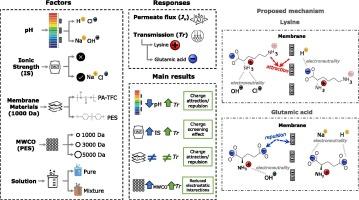Charge-selective separation of amino acids with ultrafiltration and nanofiltration
IF 8.1
1区 工程技术
Q1 ENGINEERING, CHEMICAL
引用次数: 0
Abstract
Polymeric spiral wound membranes with a nominal molecular weight cut-off (MWCO) between 1000–5000 Da were applied to separate single glutamic acid or lysine. The focus of the study was the influence of charge exclusion on the separation. Three pH values were assessed, at which these amino acids are negatively or positively charged, or electrically neutral. The pH slightly affects the permeate flux but significantly influences the transmission of both amino acids. Adding NaCl reduces this effect on transmission at alkaline conditions due to charge screening. The type of membrane material, polyethersulfone or polyamide, also affects the effect of charge on amino acid transmission. The effects can be explained by the number of charges of the amino acids and small ions (H+, Cl−, Na+, and OH−) interacting with the negatively charged membrane surface. Both amino acids were mixed at different concentration ratios of lysine to glutamic acid at pH 8. The presence of glutamic acid in mixtures strongly decreased the lysine transmission compared to solutions of just lysine. This effect vanished after the addition of NaCl. The charge impact from changing solution pH and salt content on amino acid transmission was reduced with larger nominal MWCO values, corresponding to larger membrane pore sizes.

求助全文
约1分钟内获得全文
求助全文
来源期刊

Separation and Purification Technology
工程技术-工程:化工
CiteScore
14.00
自引率
12.80%
发文量
2347
审稿时长
43 days
期刊介绍:
Separation and Purification Technology is a premier journal committed to sharing innovative methods for separation and purification in chemical and environmental engineering, encompassing both homogeneous solutions and heterogeneous mixtures. Our scope includes the separation and/or purification of liquids, vapors, and gases, as well as carbon capture and separation techniques. However, it's important to note that methods solely intended for analytical purposes are not within the scope of the journal. Additionally, disciplines such as soil science, polymer science, and metallurgy fall outside the purview of Separation and Purification Technology. Join us in advancing the field of separation and purification methods for sustainable solutions in chemical and environmental engineering.
 求助内容:
求助内容: 应助结果提醒方式:
应助结果提醒方式:


